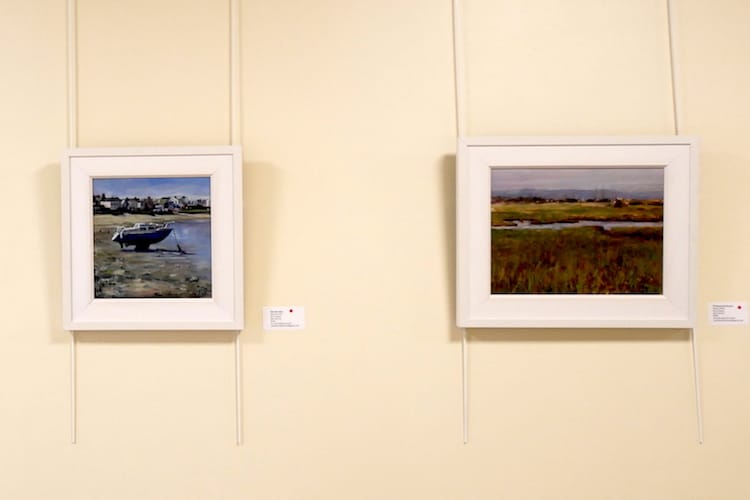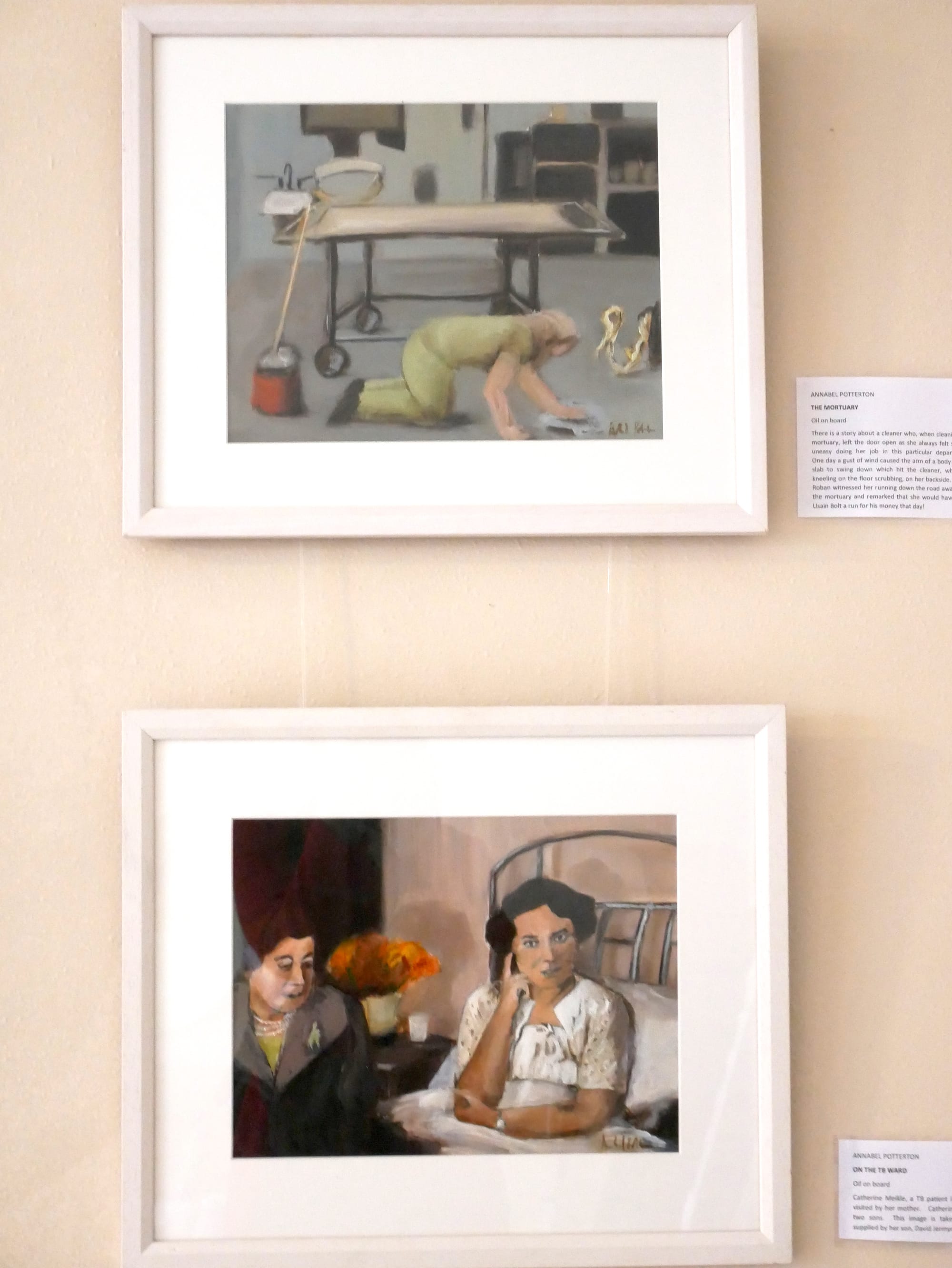What’s the best way to tell area residents about plans for a new asylum shelter nearby?
The government should tell communities directly about plans for new asylum shelters, some activists and politicians say.
The collective is mostly staff members who are artists, and professional artists with links to Connolly Hospital.

On the winding walk up to Connolly Hospital in Blanchardstown, nearby trees fan out into woodland, some of which is reflected in the artworks hung up inside.
On a recent rainy Friday afternoon, the intercom voice over the main entrance reminded anyone loitering outside that smoking damages your health. Indoors, the corridors are flooded with natural light.
Theresa King, a senior medical scientist in the haematology lab was on her lunch break. She and a colleague in the lab, Louise Boggan, had a little time for a brief tour around the hospital’s artistic highlights.
In 2015, King founded the Connolly Collective, an art group creating and exhibiting works within the hospital, with an aim to brighten up a traditionally clinical setting.
Since then, the collection has grown, and King has ideas on how she would like to see it diversify.
King started out in NCAD on Thomas Street, but left because she “had to have a job”, she says. Years later, she has her own studio at home, and tries to exhibit once a year.
In 2015, to mark the hospital’s sixtieth birthday, she formed the Connolly Collective to put on an exhibition celebrating the hospital’s history.
“The manager gave us space in the administration building. It went so well we got to keep it,” says King. The artists involved made a permanent donation of their works to the hospital.
The collective is mostly made up of staff members who are artists, and professional artists with links to the hospital.
Staff and artists add to the collection regularly, but the hospital has to be careful about what they accept. “Some people’s art is another person’s nightmare,” says King.
On top of that, pieces need to be easily cleanable, for hygiene reasons, says Boggan.
The collective recently reached out to Joanne McAndrew, a local artist who has spent a lot of time in and out of the hospital visiting her father in previous years.

Last week, McAndrew opened her first solo exhibition, Ciúin, on one of the corridors upstairs.
“I loved what they’re doing; bringing art into a clinical setting,” says McAndrew. “It makes it more of a homely environment. It can help patients get out of their head.”
McAndrew’s paintings, in deep greens and watery blues, hang on metal rails down a hallway.
They are mostly of water, in places a lot of people would recognise, she says: the 12th lock, Portmarnock, or the Tolka Valley.
This was a big part of the feedback from patients she says. “The familiarity of scenes, and people saying, ‘Oh, I walk there,’” she says.
King only began calling herself an artist recently, she says. She tends towards landscapes and the abstract.
“I’m looking down a microscope all the time. That’s where I get my inspiration,” she says, laughing.
“It’s a beautiful building. We’re very respectful of the architecture,” says King, climbing the stairs to the first floor. “We’re very slow to put artwork on these walls,” she says, waving an arm at the brightly lit symmetry of the stairwell.
“Connolly was a TB hospital, so light was very significant,” she says. (The spread of tuberculosis is impeded by ultraviolet light.)
Near the entrance to the Maple Ward is a piece by Boggan called “All the Amylase.” It’s made up of 120 different slides, each with a residual red dot from testing for the enzyme amylase under a microscope.
“The intensity of colour is directly proportional to the amount of enzyme,” says Boggan.
Near the end of the corridor, King stands by “Super Moon on Woodlands”, one of her paintings, which shows the light of a supermoon illuminating the old TB units at night, shrouded by trees.
Hanging rails donated by the Blanchardstown Hospital Society, and Prof. Tom Walsh, a general surgeon, have allowed the artists to display their work in the main hospital buildings, explains King.
Before that, they only had the little-seen administration-building space near the back of the hospital grounds.
The paintings, collages, prints and drawings lining the halls are mostly bright and colourful, and largely reference daily life in the hospital.

More than once, a “parliament” of rooks appears, a nod to the birds that reportedly populate the hospital grounds.
“At about 5 o’clock, there are rooks everywhere. It’s like something out of Hitchcock,” says Boggan.
Boggan and King bonded in the lab over their love of art. Boggan’s been at Connolly for nine years, King for eleven.
“It’s nice to give something back to the hospital. It’s good for patients and for staff. A lot of people are stuck in here for months, and sometimes they’re not very mobile,” says Boggan.
“It makes things more interesting, and less grim.”
The hospital is like one huge gallery, says King, and they’re hoping to start work in the outpatients clinic soon.
King leads the way to the administration building, which was built in the 1950s, and is a little worn around the edges. “A distressed building,” she says, with a smile.
Inside the main door are portraits of the people who have worked here over the years.
“We have cyanotypes, watercolours and prints,” says King. And more rooks.
“We haven’t decided on a name for the gallery. Maybe the Stairwell Gallery,” says King. The exhibition space looks out onto the new hospital building.
The floor is discoloured “from over 60 years of cleaning products”, says King. But the walls are bright, and covered in artwork left over from previous exhibitions.
“This exhibition is based on colour, and the healing power of colour,” says King. The artworks on display are for sale, and 20 percent of the proceeds go to the Blanchardstown Hospital Society.
With more donations, they’ve been able to hang more work in the main hospital. In future, King wants a dedicated wall for staff art, and to invite the Blanchardstown camera club to exhibit, creating links between the community and its hospital.
Get our latest headlines in one of them, and recommendations for things to do in Dublin in the other.